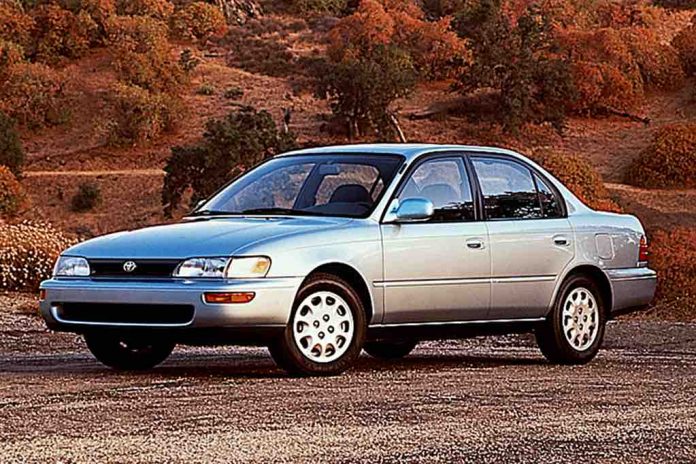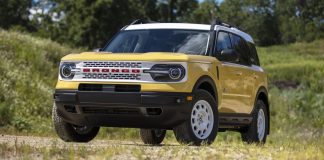It’s surprising how much hasn’t changed over the past 25 years.
New cars start right up; don’t stall and are pretty much maintenance-free for years. And so were the cars made 25 years ago.
Arguably cars – the fundamental technology – was perfected in the ’90s. The pace of functionally meaningful improvements has gone from a a run to a fast walk to a crawl.
New cars have gadgets, of course, that weren’t available 25 years ago. Things like LCD touchscreens – and better stereos. But the mechanical things haven’t improved much; they’ve just gotten a lot more complex.
Consider the night-and-day difference between a 1970 model economy car and a 1995 economy car vs. a current economy car.
It’s the difference between jumping the Grand Canyon – and jumping a creek.
. . .
Got a question about cars, Libertarian politics – or anything else? Click on the “ask Eric” link and send ’em in!
If you like what you’ve found here please consider supporting EPautos.
We depend on you to keep the wheels turning!
Our donate button is here.
If you prefer not to use PayPal, our mailing address is:
EPautos
721 Hummingbird Lane SE
Copper Hill, VA 24079
PS: Get an EPautos magnet (pictured below) in return for a $20 or more one-time donation or a $10 or more monthly recurring donation. (Please be sure to tell us you want a sticker – and also, provide an address, so we know where to mail the thing!)
My latest eBook is also available for your favorite price – free! Click here. If that fails, email me and I will send you a copy directly!












I’ve adopted a nearly 25-year-old Camry from a recently-deceased relative as my daily driver.
All I’ve done so far is change fluids/filters (& replace a stuck thermostat) & I get 25 mpg in the city.
Looks rough, clear-coat peeling off, but a visit to MAACO next spring will take care of that for awhile.
Amazing how well (built-in-Japan) this 3rd-generation Camry still drives.
Having owned 3 of those 70s-era economy cars (I know, slow learner), I will categorically state that it isn’t “It’s the difference between jumping the Grand Canyon – and jumping a creek.” It was more like landing in the creek. Or the canyon. Take your pick.
I have often thought about what cars would be like if there was no CAFE, no NHTSA and no EPA. They would likely be dirtier, faster, less efficient and likely less saaaaaaaaaafe. Fewer people would likely drive and own them for those reason as they wouldn’t be as easily piloted by people who got their license off a milk carton. The roads would likely have less traffic. Car makers would likley be marketing the hell out of their cars to induce us to buy. There would be more color choices, more suspension and braking choices. Styling would likely be more distinctive. There would be more companies building cars and specialization would have followed with each brand. Toyota would likely still be the king of reliability. VW would have the most fuel efficient, GM the most powerful. Speaking of GM, Pontiac and Oldsmobile would likely remain. Buick and Chevy might be gone based on the fact they largely make dull cars. Saturn might not have been, but with fuel issues, they would have been their efficiency brand. Electronics would have been used mainly for things like navigation and audio like they are today without all of the Big Brother tech.
Things like ABS and active suspensions would have been developed for high end cars, but cheap cars would have the basics.
SUVs and Trucks would be rarer and exciting two and 4 door cars would have been built likely with much better handling than yesterday’s cars. (just like today).
There would likely be more color, paint and trim choices across the board as cars would likely not be a sea of grey, white and silver as they are today.
What say you?
25 years ago is when widespread implementation of smog testing and other drivetrain regulation went into effect. Not just in major metropolitan areas. Nothing stifles innovation like a bureaucrat.
Hi RK,
If you dig into the EPA’s “bins” and “tiers” – deliberately inscrutable stuff – you find that the meaningful difference in exhaust emissions circa ’95 vs. today is negligible. The big reductions – the ones that made a difference – happened during the ’70s, ’80s and up to the early ’90s.
After that – since then – it’s been angels-dancing-on-the-head-of-a-pin stuff.
I would respectfully submit it was even before that. The worst of tailpipe pollution would have been in the 40’s or 50’s- with leaded fuel, road draft tubes and relatively primitive metallurgy which allowed engines to wear out in 30-50k miles- leading to lots of obvious oil smoke in the air. Today it is truly rare to see a car smoking oil. The switch from carbs to fuel injection was an improvement, but a well tuned carb really isn’t any worse than injection under most conditions.
Agree, Ernie!
Also: How much “cleaner” would it be if a typical car averaged 60 MPG – as they could and would, were it not for Uncle?
Which is why the VW thing is so infuriating.
The “cheating” cars are so much more efficient, that they likely have a lower overall emissions than the “fixed” cars.
If the government were truly worried about emissions and fuel economy, they would be pushing diesels in light trucks/suv.
These are by far the most sold vehicles, and a half ton pickup getting 30mpg would make more of a difference than a Prius getting 50mpg.
I submit that the most substantial tailpipe reductions were done by 1980. 1980 was the last of the 1970 phase in. Between 1980 and 1991, the standards remained frozen. Then.. Bush, and by 1996, new standards for OBD and emissions that just recently were promulgated sometime in the early 2010s. By 1980, the new cars were emitting 1/10th the level of CO, HC and NOX of the 1970 models. It should have been mission accomplished. The only two good things that came out of the 1990 regulations were the adoption of across the board OBD2 and the regulation that forced car parts stores to take used oil instead of classifying it as a hazardous waste. Prior to that, some of these clowns were charging disposal fees or not taking it at all.
swamp, had they stopped then, you might have forgotten who the “boss” is. They can’t have that. They dictate, everybody jumps.
Aside from computers and those brain-eating devi…err, I mean “smartphones”, the same could be said for pretty much every other form of modern technology. Since the majority of it has been perfected, fundamental progress has become stale. So now what do you do? Well, as you like to put it, you “sex them up”. Bog ’em down with more unnecessary “bells and whistles” and give them slick exteriors in a lame attempt to stand out from every other brand.
Damn it! Logged out by accident. lol
Hi Anon,
Yup. The tragedy is that huge improvements – in mileage and cost reduction – could easily be achieved, were it not for the government. Economy cars should be averaging 60 MPG – with gas engines. With diesel engines, they could be averaging 80.
People should be able to buy a mid-sized family car with AC and most of the genuinely helpful power options for around $15,000.
Instead, we’re being shoved into $30,000-plus electric cars.
The auto business probably would have mirrored the electronics and computer business by getting cheaper over time.
It’s too bad its so hard to point out what was lost by over regulating everything.
I realize Why cellphones went from analog to digital but both could have existed concurrently for those who didn’t want or need a digital phone. Of course, remaking a product where the old style no longer works is just good bidness for the corporations who rip us off in every way they can.
When I was able to use a handheld phone instead of a bag phone, I felt like it couldn’t get any better. The handheld could be hooked to the same antenna as the bag phone with an A dapter kit and talk long distances. The digital bs put the kibosh on long distances unless you were willing to spend $400 on a cell phone booster. I wasn’t.
My 1996 Nissan Maxima still drives just fine after 220k miles. I’ve taken good care of it.
It does most of what modern cars do.
Well, it has a car stereo which could be better. I could upgrade if I want. A new one could communicate with my cell phone.
Other wise, it starts, runs, and drives just fine. It doesn’t look like it’s way out of style.
Best of all, it’s all mine. No payments. I do my own repairs. The cars fuel injection system is modern enough to have OBD-2, and simple enough that an experienced diy owner can deal with it.
Z32, E36, SN95, E39, SW20, TJ, etc.
Plenty of toys out there, not enough time for them all. Remember, easier to modernize whatcha want (headlights, radio, interior bulbs) than to remove whatcha don’t want
Spot on Eric. I’ve said for a long time, “the 1997’ish chevy truck was about perfect for a truck”
IF, we didn’t have ever increasing regs, they would now be made by the 3rd world and be for sale here for $15-20K. AND be a just fine good truck. But we all know why Uncle and the US manufacturers had to get in bed to ever increase the regs.
And obviously, same could be said for corollas, etc… and then we get hoodwink’d again with the way overbearing diesel regs changed in the late 2000’s. I think they overshot that one bad, cause no one wants them anymore with $10K repair bills at 100K miles.
Chris, my cousin and I were looking over the 98 Turbo Diesel he found and brought to me…..cheap. We were speaking of those good old days and he said he also owned a 93 Turbo Diesel like mine and we both said at the same time “the good ones” since they were mechanical injection. There really was only one problem with the later models and that was the PSD unit had been installed down in the V of the valley of the engine, too hot to live there. The 98 has a new one with wiring for remote relocation in the back seat.
I probably won’t ever use it since the 98 is just a donor body for the 93, a much more comfortable trucks and more reliable with NO computer. It has one less “secret” compartment than the mechanical injection in the 92 and 93.
Secret compartments, reminds me of a law passed a few years ago. You can be charged for having a “secret” compartment in/on your vehicle…..even if it’s factory. Amazing eh? The 92=93 x cab has 4 of them. One each side of the back seat, one under the cupholder in the console and one behind the glove box where the computer would have been on other models.
The cops came up with this one and of course, the courts fell all over themselves making it de facto law.
The 96 model was the first year of the Vortec engine. It made more power and breathed a lot better but the older engine with flat tappets lasted longer. They were simpler too with TBI and no air bags till 95.